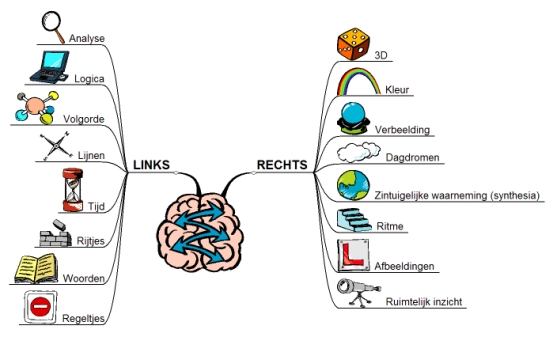|
Research has shown that the Mind Mapping method is a lot more efficient when storing, remembering, and retrieving information than any other method whatsoever. This is because Mind Mapping stimulates and uses the collaboration of both our cerebral hemispheres. This was shown after a modern brain research in the field of memory techniques and accelerated learning techniques. |
|
Our two cerebral hemispheres appear to have a preference:
|
|
Left cerebral hemisphere
|
Right cerebral hemisphere
|
|
analysis
logic
order
lines
time
lists
words
rules
|
three-dimensional insight
rhythm
images
colour
3D
imagination
daydreams
sensory perceptions
|
![]()
|
For many people it is more pleasant to display this information as an image:
|
||
 |
|
Scientific research has shown that we function considerably less good if our cerebral hemispheres are not optimally stimulated to collaborate with each other. Our brains appear to function on the basis of pattern recognition. If something functions in a certain way, we are inclined to keep doing it in that way. Edward de Bono, renowned for his work in the field of the functioning of our brains, has once compared this to thick lemonade syrup that is poured slowly over a pudding. First the syrup finds it way over the slippery surface of the pudding. Once small grooves are worn away the syrup will follow this ‘already beaten track’. That’s how our brains function more or less as well. Huge inventions are made by exactly deviate from the beaten track. By finding new ways, making new connections, by means of cross-fertilisation. Mind Mapping stimulates you to make new connections. After primary school there are few people that regularly make drawings and work with colours. A lot of information that we have to process later is written in black & white. We learn to write down lists (by heart). The right cerebral hemisphere is stimulated less and less. At a grown-up age a large part of our creativity has ‘slipped away’ since we receive few incentives to fully use this characteristic. One of the most important methods in order to remember information for a longer period of time is the creation of associations. In prehistoric times that was the way in which important information was remembered. Taste and smell of food, rhythm of hostile drums, colours of insects and snakes, temperature of the water, movements of dangerous animals. Everything was associated with colour, sound, taste, smell, movement, etc. Our environment has meanwhile changed but these prehistoric mechanisms are still fully intact. Mind Mapping stimulates the registration, processing, and retrieving of information in images, also called ‘image thinking’ or ‘visual thinking’. |
Onze beide hersenhelften blijken elk hun eigen voorkeuren te hebben bij informatieverwerking:

Edward de Bono, bekend door zijn werk op het gebied van de werking van onze hersenen, heeft dit wel eens vergeleken met dikke limonadesiroop dat langzaam over een pudding wordt gegoten. Eerst zoekt de siroop naar een weg over het gladde oppervlak van de pudding. Als er eenmaal gootjes zijn uitgesleten dan zal de siroop deze ‘reeds bewandelde paden’ volgen. Zo werken onze hersenen min of meer ook. Grote uitvindingen worden gedaan door juist van de gebaande paden af te wijken. Door nieuwe paden in te slaan, door nieuwe verbindingen te maken, door kruisbestuiving. Mindmapping stimuleert je om nieuwe verbindingen te maken.
De rechter hersenhelft wordt minder en minder gestimuleerd. Op volwassen leeftijd is een groot deel van onze creativiteit ‘weggezakt’ omdat we weinig prikkels meer krijgen om deze eigenschap ten volle te benutten. Na de basisschool zijn er nog maar weinig mensen die regelmatig tekeningen maken en met kleuren werken. Veel informatie die we later moeten gaan verwerken is in zwart/wit opgeschreven. Wij leren rijtjes (uit ons hoofd) op te schrijven.
Een van de belangrijkste methoden om informatie langere tijd te kunnen onthouden is door het maken van associaties. In de oertijd was dat de manier waarop belangrijke informatie werd onthouden. Smaak en reuk van voedsel, ritme van vijandelijke trommels, kleuren van insecten en slangen, temperatuur van water, bewegingen van gevaarlijke roofdieren. Alles werd geassocieerd met kleur, geluid, smaak, reuk, beweging etc. Onze omgeving is inmiddels veranderd maar deze oermechanismen zijn nog volledig intact.
